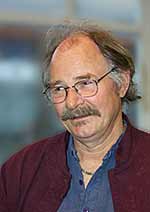
Mike Dodd
October 2000



Mike Dodd
October 2000
Mike Dodd was born in Sutton, Surrey in 1943. He attended Bryanston School, Dorset, from the age of fourteen and studied pottery under Donald Potter who in turn was a student of Eric Gill. He left Cambridge University in 1965 with an honours degree, and took a post-graduate course in Ceramics at Hammersmith College of Art in London.
Mike opened his first pottery at Edburton near Brighton, Sussex in 1968. He built a double chamber wood-fired kiln and produced ash glazed stoneware and porcelain for four years before moving the pottery to larger premises at Battle, Sussex. In 1975 he moved to Hale, Cornwall where he built a Korean style climbing kiln from local Cornish materials and started producing his own glazes from local granites, clays, wood ashes, irons and ochres.
Mike's experience of building and using the Korean kiln led the organizers of the Amuesha Indian Project to ask him to build a similar kiln in the central jungles of Peru. The project was aimed at keeping the indigenous people in their natural home. He spent six months working with the American project leader, Connie Talbot.
Cumbria was Mike's next home. He had been a Senior Lecturer and then Department Head at Cumbria College of Art since 1981, and in 1986 moved his pottery to Boltongate in Cumbria. Again he sought out local materials for his glazes, using granites, hornsfels (hornsfel is a metamorphic rock type created when igneous and sedimentary rock is subjected to great temperatures, pressures or both), andesites (volcanic rock), irons and ashes.
Mike returned to the south in 1994, this time to Beaminster, Dorset, where he stayed until 1999 when he moved to his present home, Butleigh in Somerset. Mike says that when he moves from Butleigh it will be feet first.
Apart from those already mentioned, Mike has held teaching positions at Farnham College of Art, Medway College of Art, Harrow College of Art, the Royal College of Art, Derby College of Art, Dundee College of Art, Manchester Polytechnic, Preston Polytechnic, and has addressed the International Potters' Camp at Aberystwyth, the Functional Pottery Conference at Bolton, the Landshut College for Ceramics in Germany the workshop at Golen Bridge Pottery in Pondicherry, India. He has written numerous articles for magazines and has been written about just as frequently.
His work is in the collections of the Victoria and Albert Museum, the British Craft Council, Bath Study Centre, the Clevedon Craft collection and Ulster Museum.
In Mike's own words . . .
|
Form, quality of surface, sensitivity of touch, appropriateness of clay and firing incidentals all contribute to a visual and tactile language more visceral than conceptual, which deepens through continual acquaintance and use. To help develop this language I use naturally occurring rocks, clays and wood-ashes in formulating glazes. The complex of metal oxides present in granite, hornsfels, andesite and basalt provide unique and beautiful glazes closely related to Mother Earth's seasonal colours. The search for strong form and for glazes which can enhance and elucidate this formal language requires commitment and continual choice. Finally, the work is surrendered to the fire. Although disasters occur, they are more than compensated by "gifts from the kiln" - those pots that are better than you could have hoped for. These prove the spur to deepen understanding - an understanding, it is hoped, which quietly communicates itself at times of use and contemplation.  |